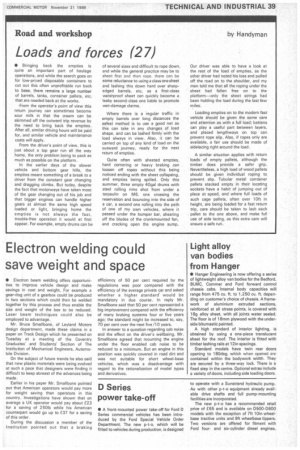Road and workshop
Page 41

If you've noticed an error in this article please click here to report it so we can fix it.
by Handyman
Loads and forces (27)
• Bringing back the empties is quite an important part of haulage operations, and while the search goes on for low-priced disposable containers to cut out this often unprofitable run back to base, there remains a large number of barrels, tanks, container pallets, etc, that are needed back at the works.
• From the operator's point of view this return journey can sometimes become sour milk in that the cream can be skimmed off the outward trip revenue by the need to bring back the empties. After all, similar driving hours will be paid for, and similar vehicle and maintenance costs will apply.
From the driver's point of view, this is just about a top gear run all the way home, the only problem being to pack as much as possible on the platform, In the earlier days of the slower vehicle and bottom gear hills, the empties meant something of a break to a driver from the constant gear changing and dragging climbs. But today, despite the fact that motorways have taken most of the gear changing out of his job and that bigger engines can handle higher gears at almost the same high speed loaded or light, bringing home the empties is not always the fast, trouble-free operation it would at first appear. For example, empty drums can be of several sizes and difficult to rope down, and while the general practice may be to sheet first and then rope, there can be some reluctance to using a class onesheet and lashing this down hard over sharpedged barrels, etc, as a first-class waterproof sheet can quickly become a leaky second-class one liable to promote wet-damage claims.
Where there is a regular traffic in empty barrels over long distances the safest method is to use a good net as this can take in any changes of load shape, and can be lashed firmly with the load always in view. Also, it can be carried on top of any kind of load on the outward journey, ready for the next return of empties.
Quite often with sheeted empties, hard cornering or heavy braking can loosen off ropes without this being noticed ending with the sheet collapsing, and empties being spilled. Only this summer, three empty 40gal drums with steel rolling rims shot from under a tarpaulin on M6, one crossing the reservation and bouncing into the side of a car, a second one rolling into the path of one of my own vehicles, where it passed under the bumper bar, shearing off the blades of the crankmounted fan, and cracking open the engine sump. Our driver was able to have a look at the rest of the load of empties, as the other driver had noted his loss and pulled off the road on to the shoulder, and my roan told me that all the roping under the sheet had fallen free on to the platform—only the sheet strings had been holding the load during the last few miles.
Loading empties on to the modern fast vehicle should be given the same care and attention as with a full load: battens can play a useful part between layers, and placed lengthways on top can prevent rope slip. Also, if ropes only are available, a fair use should be made of sidelacing right around the load.
A similar situation applies with return loads of empty pallets, although the timber does provide a safer grip. Nevertheless, a high load of wood pallets should be given individual roping to prevent slip. Tubular metal container pallets stacked empty in their locating sockets have a habit of jumping out of place at speed, and where full loads of such cage pallets, often over 10ft in height, are being loaded for a fast return trip, care should be taken to lash each pallet to the one above, and make full use of side lacing, as this extra care will ensure a safe run.




































































































